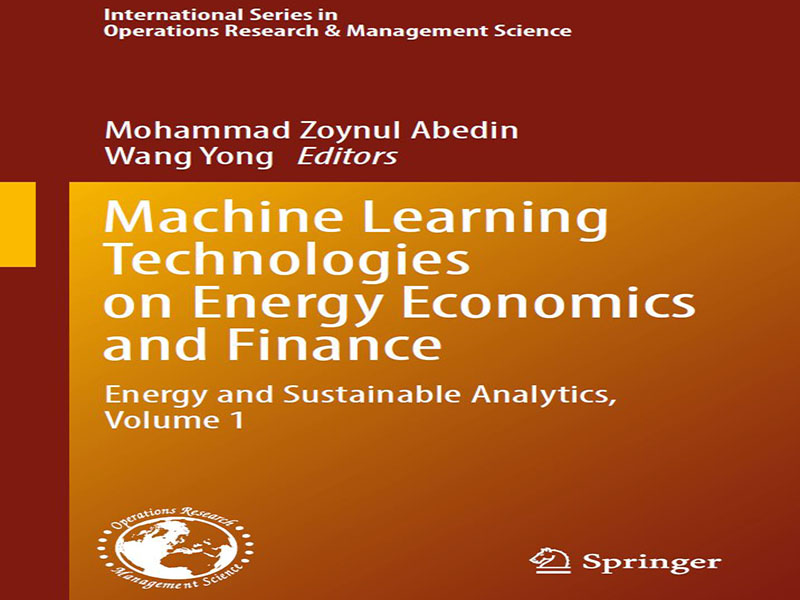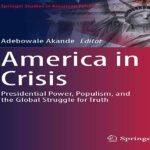- عنوان کتاب: Machine Learning Technologies on Energy Economics and Finance Energy and Sustainable Analytics, Volume 1
- نویسنده: Mohammad Zoynul Abedin, Wang Yong
- حوزه: کاربرد یادگیری ماشین
- سال انتشار: 2025
- تعداد صفحه: 336
- زبان اصلی: انگلیسی
- نوع فایل: pdf
- حجم فایل: 5.90 مگابایت
پایداری از زمان پیدایش خود در حوزه اقتصاد و اندیشههای زیستمحیطی به یک مفهوم برجسته برنامهریزی تبدیل شده است (Nguyen et al., 2023). پایداری که به عنوان تلاشی برای برآوردن نیازهای فعلی بدون در نظر گرفتن توانایی نسلهای آینده برای انجام همان کار توصیف میشود، چندوجهی است. مفهوم پایداری انرژی اساساً اصول اساسی پایداری را در حوزه انرژی به کار میبرد (Khan et al., 2022). با این حال، مفهوم پایداری انرژی پیچیده و چندوجهی است. این مفهوم شامل تضمین ارائه خدمات انرژی به شیوهای پایدار است و در نتیجه مستلزم ارائه خدمات انرژی است که برای همه افراد در حال حاضر و آینده کافی، مقرون به صرفه، سازگار با محیط زیست و از نظر اجتماعی قابل قبول باشند (Achuo et al., 2022). پایداری انرژی، استفاده پایدار از انرژی را در سیستمهای انرژی الزامی میکند و فرآیندهای مختلفی را از منبعیابی انرژی تا تبدیل آن به اشکال قابل استفاده، حمل و نقل، ذخیرهسازی و مصرف نهایی در بر میگیرد (Jiang et al., 2020). انرژی در درجه اول برای ارائه خدمات انرژی مانند گرمایش، حمل و نقل، روشنایی و ارتباطات استفاده میشود. در نتیجه، ارتقای پایداری انرژی به ایجاد و بهرهبرداری از سیستمها و شیوههای انرژی پایدار وابسته است (Zaharia و همکاران، 2019). پایداری انرژی یک جزء حیاتی از مفهوم گستردهتر پایداری است. بسیاری از کشورها، مناطق و مناطق شهری در تلاش برای دستیابی به پایداری هستند و ارزیابی مجدد شیوههای انرژی ناپایدار فعلی خود را ترویج میدهند (Qudrat-Ullah & Nevo، 2021). به عبارت ساده، پایداری با ابعاد زیستمحیطی، اجتماعی و اقتصادی مشخص میشود که همگی به طور پیچیدهای با انرژی مرتبط هستند. انرژی، که برای فعالیتهای مختلف ضروری است، نقش مهمی در دستیابی به پایداری ایفا میکند. دستیابی به پایداری انرژی با موانع زیستمحیطی، اجتماعی و اقتصادی قابل توجهی، از جمله تغییرات اقلیمی، افزایش انتشار گازهای گلخانهای، کاهش سریع منابع، نگرانیهای مربوط به مقرون به صرفه بودن و نابرابریهای اجتماعی، مواجه است (Bibi و همکاران، 2021). پرداختن مؤثر به این چالشها برای دستیابی به پایداری انرژی ضروری است، اما همچنان یک کار دلهرهآور و پیچیده است. عواملی مانند قیمتهای مصنوعی انرژی که تحت تأثیر مالیاتها، مشوقها، نوسانات اقتصادی و سیاسی قرار دارند، چشمانداز پایداری و مصرف انرژی را پیچیدهتر میکنند (Ozcan و همکاران، ۲۰۱۹). اهداف توسعه پایدار (SDGs)، که در سال ۲۰۱۵ توسط مجمع عمومی سازمان ملل متحد (UNGA) تصویب شدند، چارچوبی قوی برای تقویت همکاری بینالمللی با هدف تحقق آیندهای پایدار برای جهان ارائه میدهند. ۱۷ هدف از SDGs، به همراه ۱۶۹ هدف آنها که در «دستور کار ۲۰۳۰» گنجانده شدهاند، مسیری را برای ریشهکن کردن فقر شدید، مبارزه با نابرابری و بیعدالتی و حفاظت از محیط زیست ترسیم میکنند. موفقیت دستور کار ۲۰۳۰ به طور قابل توجهی به انرژی پایدار وابسته است. SDG 7، هدف جهانی انرژی، شامل سه هدف محوری است: تضمین خدمات انرژی مدرن قابل دسترس، قابل اعتماد و گسترده، افزایش قابل توجه سهم انرژیهای تجدیدپذیر در ترکیب انرژی جهانی و دو برابر کردن نرخ جهانی افزایش بهرهوری انرژی. اهداف متنوع در SDG 7 در پیشبرد سایر اهداف SDG نقش دارند، موضوعی که اخیراً توجه تحقیقات را به خود جلب کرده است (آلن و همکاران، ۲۰۱۶). بررسیهای قبلی مسیرهای انرژی آینده، امکانسنجی فنی دستیابی به دسترسی بیشتر به انرژی، کیفیت هوا و قابلیت اطمینان انرژی را به طور همزمان، در عین جلوگیری از تغییرات خطرناک آب و هوایی نشان میدهد. در واقع، فناوریها و استراتژیهای جایگزین مختلفی به عنوان قادر به دستیابی به این اهداف شناسایی شدهاند (اسملاش و همکاران، ۲۰۲۰). در طول قرن بیستم، بشر با بهرهگیری از قدرت پیشرفتهای علمی و نوآوریهای تکنولوژیکی، تلاشهای خود را گسترش داد. نتایج آن در افزایش سریع جمعیت جهان و دستیابی به استانداردهای بالای زندگی در کشورهای توسعهیافته مشهود است. از آنجایی که جوامعی که الگوهای تولید و مصرف انبوه را در این مناطق پذیرفتهاند، به یک مسئله پایدار تبدیل شدهاند. پیامدهای این الگوها فقط به این کشورها محدود نمیشود؛ آنها تأثیرات قابل توجهی بر کشورهای در حال توسعه نیز گذاشتهاند. جمعیت جهان به عرضه انرژی فراوان وابسته شده است. در نتیجه، نیاز به یک مخزن انرژی قابل توجه منجر به اتکای شدید به سوختهای فسیلی شده است که به دلیل انتشار دی اکسید کربن بدنام هستند. از این رو، تهدید قریبالوقوع گرمایش جهانی ناشی از تجمع دی اکسید کربن در جو، به موضوع بحثبرانگیزی تبدیل شده است (هلتن، ۲۰۱۳). عامل اصلی نوسان در عرضه و تقاضا را میتوان مستقیماً به سیستم جداسازی نسبت داد. در سال ۲۰۱۹، چین ۲۴٪ از کل انرژی جهان را تولید میکرد.
Sustainability has become a prominent planning concept since its inception in the realm of economics and ecological thought (Nguyen et al., 2023). Described as the endeavor to satisfy current needs without comprising the ability of future generations to do the same, sustainability is multifaceted. The notion of energy sustainability essentially applies the fundamental principles of sustainability to the realm of energy (Khan et al., 2022). However, the concept of energy sustainability is intricate and multifaceted. It encompasses ensuring the delivery of energy services in a sustainable manner, thereby necessitating the provision of energy services that are adequate, affordable, environmentally friendly, and socially acceptable for all individuals both presently and in the future (Achuo et al., 2022). Energy sustainability mandates the sustainable utilization of energy within energy systems, encompasses various processes from sourcing energy to its conversion into usable forms, transportation, storage, and eventual consumption (Jiang et al., 2020). Energy is primarily utilized to deliver energy services like heating, transportation, lighting, and communication. Consequently, the promotion of energy sustainability hinges on the establishment and utilization of sustainable energy systems and practices (Zaharia et al., 2019). Energy sustainability is a vital component of the broader concept of sustainability. Numerous nations, regions, and urban areas are striving toward sustainability, promoting a reassessment of their current unsustainable energy practices (Qudrat-Ullah & Nevo, 2021). Simply put, sustainability is char-acterized by environmental, social, and economic dimensions, all of which are intricately linked to energy. Energy, being essential for various activities, plays a crucial role in achieving sustainability. The pursuit of energy sustainability is impeded by significant environmental, social, and economic obstacles, includ-ing climate change, escalating emissions, rapid resource depletion, affordability concerns, and social disparities (Bibi et al., 2021). Addressing these challenges effectively is imperative for the attainment of energy sustainability, yet it remains a daunting and intricate task. Factors like artificial energy prices influenced by taxes, incentives, economic, and political fluctuations further complicate the landscape of energy sustainability and consumption (Ozcan et al., 2019). The sustainable development goals (SDGs), which were endorsed by the United Nations General Assembly (UNGA) in 2015, present a robust framework for fostering international collaboration aimed at realizing a sustainable future for the globe. In 17 goals of SDGs, along with their 169 targets encapsulated in “Agenda 2030,” lay out a trajectory toward eradicating extreme poverty, combating inequality and injustice, and safeguarding the environment. The success of agenda 2030 hinges significantly on sustainable energy. SDG 7, the global energy objective, comprises three pivotal targets: ensuring accessible, dependable, and widespread modern energy services, substantially boosting the proportion of renewable energy in the global energy mix, and doubling the worldwide rate of enhancement in energy efficiency. The diverse targets within SDG 7 play a role in advancing other SDG objectives, a subject that has gained heightened research attention recently (Allen et al., 2016). Previous examinations of prospective energy trajectories demonstrate the technical feasibility of achieving enhanced energy accessibility, air quality, and energy reliability concurrently, while averting hazardous climate alterations. Indeed, various alternative technologies and strategies have been identified as capable of attaining these aims (Asmelash et al., 2020). During the twentieth century, mankind extended its endeavors by harnessing the power of scientific advancements and technological innovations. The outcomes are evident in the swift escalation of the global populace and the attainment of elevated living standards in developed nations. As societies embracing mass production and consumption patterns become customary in these regions, the excessive utilization of resources and energy has evolved into a persistent issue. The repercussions of these patterns are not confined solely to these nations; they have also exerted notable impacts on developing countries. The worldwide population has grown reliant on a plentiful energy supply. The necessity for a substantial energy reservoir has consequently led to a heavy reliance on fossil fuels, notorious for their emission of carbon dioxide. The looming threat of global warming triggered by the accumulation of carbon dioxide in the atmosphere has hence become a pressing subject of contention (Helten, 2013). The primary trigger of the fluctuation in supply and demand can be directly ascribed to the system of segregation. In the year 2019, China represented 24% of the total global energy consumption, positioning itself as the foremost importer of crude oil and natural gas worldwide (Guo et al., 2021). Nevertheless, stringent measures implemented in early 2020 brought numerous sectors to a near halt. Furthermore, various European nations, the United States, and India jointly responsible for almost one-third of the global energy consumption have enforced a series of isolation protocols (Verhoef et al., 2023). Within this context, the global energy demand has encountered an unparalleled downturn. Consequently, the outlook of the market has turned increasingly delicate. While a gradual easing of restrictions and a slow resurgence from isolation appears inevitable in due course, the substantial setback in economic activities may endure permanently. All these elements contribute to a crucial argument: the ambiguity stemming from the crisis and the necessity for a seamless evolution of the energy sector (Biazzi, 2022). The proliferation of renewable energy sources has initiated a global energy revolution with significant geopolitical ramifications. The emergence of a novel era in energy will revolutionize the interactions among nations and societies, ushering in a new era of energy security, independence, and prosperity for humanity. In contrast to fossil fuels, which are predominantly found in specific geographical areas, renewable energy sources (RESs) can be harnessed in any country. Due to its ability to be generated in various locations, renewable energy has the capacity to reshape the dynamics of energy trading (Vagiona & Kamilakis, 2018). Earlier, Vagiona and Kamilakis (2018) propose an integrated approach for the assessment and prioritization of appropriate sites for the establishment of sustainable offshore wind farms. Through the utilization of a combination of geographic information systems and multi-criteria decision-making techniques, the generated outcomes guarantee the spatial sustainability of these wind farms. Some researchers investigate the idea of hydro-gen cities through the suggestion of hydrogen generation within urban areas. By employing Geographic Information System (GIS) tools, the monthly capacity for solar hydrogen production in urban regions of Mexico is evaluated (Juárez-Casildo et al., 2022).
این کتاب را میتوانید از لینک زیر بصورت رایگان دانلود کنید:




































نظرات کاربران